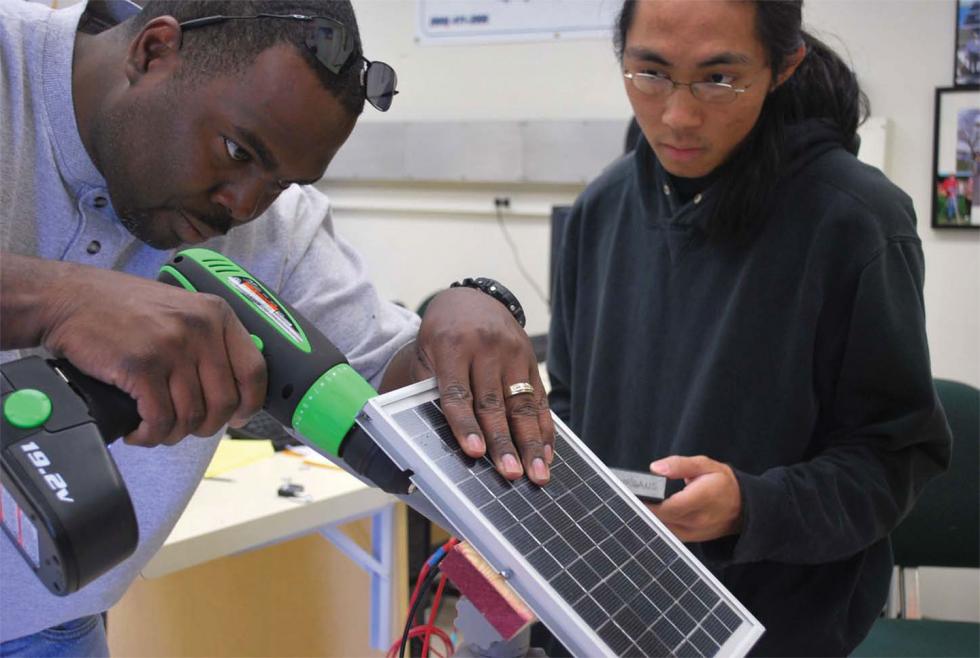It may seem odd that local colleges, universities and vocational schools are putting energy into building a large base of qualified workers in an economy that is already showing double-digit unemployment and forcing many to leave retirement.
Bad as things may be, however, they can be worse for the region’s outlook if, when the recovery comes, the bodies just aren’t there to fill the jobs. The complex recipe that creates a vibrant and thriving regional economy is based on ensuring the work force will be there when employers want it. Otherwise, even our region’s considerable qualities as a great place to live, work and play amount to virtually nil.
With this reality in mind, local schools are working hard to find the answer to the question of whom to train, for what and at what pace.
To their credit, none of the local schools even scope out a new course or curriculum without first talking to the job providers they hope will be hiring their graduates.
“Whenever we look at developing and rolling out a new program, we have advisory groups composed of professionals in the market who give us feedback on the types of jobs and expertise they’re seeking or expect to need,” says Nolan Miura, president and CEO of Heald College. “We also count on our career services counselors, who assist our graduates in finding jobs, [and] help us keep tabs on where there’s a work force shortage or surplus.”
The advisory board approach is certainly a popular one. The Los Rios Community College District has individual advisory boards for each of its 76 career training programs throughout the district. These boards review curriculum, talk to the faculty about trends in the industry and present new training needs.
“The advisory boards also provide our faculty with opportunities to step into the work arena and get an understanding for how the classroom experience can be modified to meet changing needs,” says Dan Throgmorton, associate vice chancellor for work force and economic development with Los Rios. “That rolls back into program development and creates a constant feedback loop, which ensures we’re providing the training and education employers want.”
DeVry University also organizes two separate phases of advisory workshops, one for its electronic and engineering programs and one for its business school.
“The idea is to have our department heads and instructors walk through the curriculum and get feedback from professionals in the field — the people who will be doing the hiring — on what skills they want our graduates to have,” says Marcela Iglesias, campus director for DeVry in Elk Grove.
Along with the advisory boards, most schools are also connected to local work force investment boards, which offer programs and services to provide employers access to qualified workers and to equip job seekers with skills needed for today’s job market.
Those resources, coupled with information and statistics from the federal Department of Labor and private organizations such as CareerBuilder.com, would seem to provide everything schools need to identify and directly meet current and future work force needs. In a normal economy, that might be true. In a downturn, however, there are a few inherent dilemmas.
For starters, a down economy traditionally sends more people back to school to acquire new skills, but now schools can’t possibly accommodate everyone and might even be faced with reduced class offerings. In early July, for example, the 23-campus California State University system announced it would stop accepting nearly all student applications for spring 2010 in an effort to offset budget cuts.
“Right now we’re seeing a lot of contraction in the market for teachers with larger classrooms and teachers being laid off; we see that changing by 2012.”
Mary Emery Sherman, associate regional dean, National University
“It’s ironic that here we are at the very time when we need our training institutions to be preparing the next wave of workers, and there are actually fewer options available in our training grounds,” says Virginia Hamilton, executive director of the California Workforce Association.
That is made all the more sobering by dissecting what the unemployment rate really reflects: an average. Statewide it’s around 11 percent, but when you look at people with a college degree or higher, the unemployment rate is around 4 percent. For individuals with less education, it’s closer to 14 percent, further underscoring the need for more avenues to a college education.
Hamilton also laments a Catch-22 in the lack of current jobs available in so many areas where there is likely to be a huge need in coming years.
“We’re doing a pretty good job of increasing the number of nurses graduating in the state, but with so many nurses coming back from retirement or staying at work because of the economy, the word we’re getting is the graduates aren’t getting hired,” she says. “That creates the false perception that we have a surplus. But when the recovery comes and the baby boomers retire in huge numbers, we’re going to be looking at a crisis.”
The situation with nursing is by no means an isolated one. The health care industry is universally recognized as one poised for tremendous growth, due in part to aging baby boomers and in part to all the large talk coming from Washington. Despite concerns over job openings, local schools are rushing to meet the anticipated need for talent.
Heald College has already established programs for pharmacy technicians as well as programs for medical insurance and billing, and a new nursing program is “in the hopper,” possibly rolling out next year. National University has announced it will introduce programs in radiation therapy and public health next year. Los Rios is anticipating a surge in demand for all of its allied health programs, and DeVry is seeing surging interest in its health services management concentration.
In addition to health care, which is a growth opportunity almost everywhere in the country, clean and green technologies are unquestionably in fashion and present a unique — and hopefully beneficial — opportunity for the Capital Region.
Virtually every school is embracing this emerging industry as existing companies look for ways to make operations more energy efficient and sustainable, and new companies look to become leaders in the new green market.
The Los Rios Community College District launched the GreenForce
Initiative, introducing technology such as solar panels into the
classroom.
(Photo courtesy of Los Rios Community College District)

“This is going to help Sacramento become a larger national player and green industry leader,” says Bob Eoff, vice president and director for the University of Phoenix Sacramento Valley Campuses.
University of Phoenix and DeVry University are both whispering of green technology programs that may be unveiled next year, but both will be working hard to catch up with Los Rios’ GreenForce Initiative. Funded in part by the Department of Labor, the program includes a full spectrum of offerings, from single course and basic certifications that can cast a green tint on existing skills, all the way up to a two-year degree program.
“This is a big opportunity for the region, so we’ve devised a program that includes stem curriculum, science, technology, engineering and mathematics,” Throgmorton says. “These are all applicable in areas like green building design, performance-based construction, even water and wastewater management.”
Together, health care and green technology own most of the attention of local schools. However, other areas are requiring attention as well, such as filling a pipeline of teachers.
“Right now we’re seeing a lot of contraction in the market for teachers with larger classrooms and teachers being laid off; we see that changing by 2012,” says Mary Emery Sherman, associate regional dean with National University. The school has started a bachelor’s program in interdisciplinary studies, which includes a single or multiple subject credential. “This is a cycle; classes will get larger now, go back down in about three years, and then there will be a need for teachers.”
All that said, there’s cause to be concerned about a great big sucking sound coming from the job market as the recovery turns and boomers across all industries and fields realize they can at last retire in some manner of comfort and security.
“In some fields we’re seeing that the age of the average worker is 58,” Hamilton says. “We’re anticipating that just replacing people who retire is going to create a huge need for workers in every single industry sector.”
To meet that need, Hamilton supports the idea of programs similar to what National University has done by rolling a teaching credential into a degree program.
“One of the larger issues we need to start tackling in California is education infrastructure, so students can obtain certifications and degrees that are easily stackable,” she says, pointing out that registered nurses who want to become physician assistants, for example, can’t capitalize on their existing training; they have to start from square one when they go back to school. “Schools and employers need to start taking a close look at some reform issues in our education system, so we can quickly fill the gaps retiring baby boomers are going to create.”
Recommended For You

Getting Schooled
Students delay education or seek alternatives to state-funded schools
As legislators duke it out in the Capitol and college regents slash services and raise fees, Adam Thongsavat is viewing education in California a bit differently. Namely, the UC Davis senior has been watching the growing line of students waiting for free food.

The MBA Goes Online
While employers say an online MBA can’t be as good as its on-campus counterpart, e-learning advocates disagree
Seventy percent of colleges now say online education drives their long-term growth strategies. And, where for-profit universities once dominated online MBA programs, now highly rated business schools like Kelley and the University of North Carolina’s Kenan-Flagler Business School offer them.



